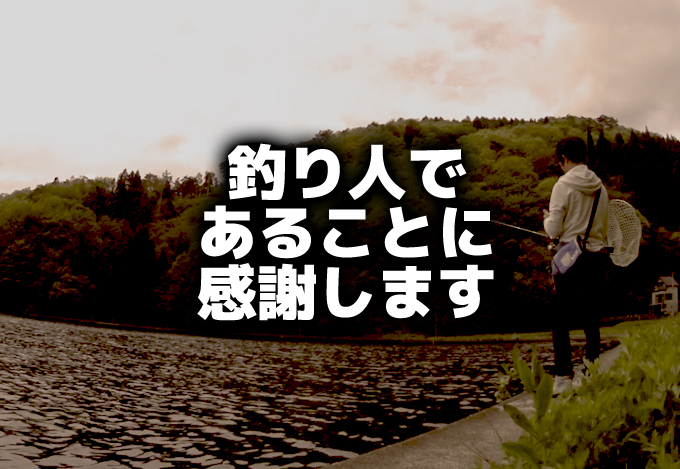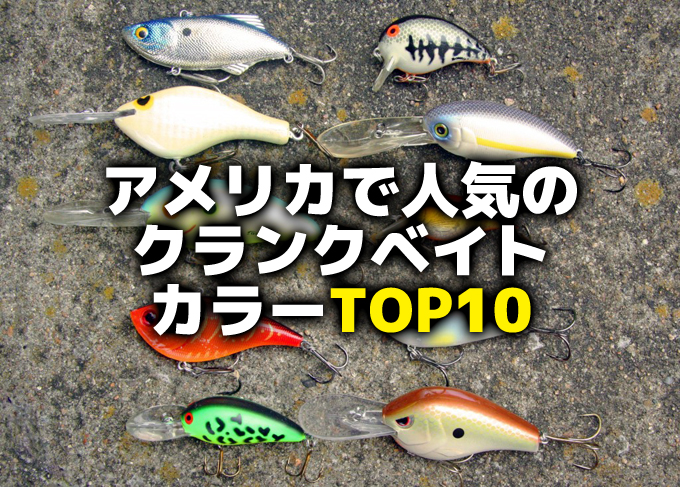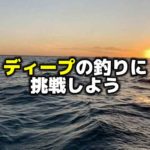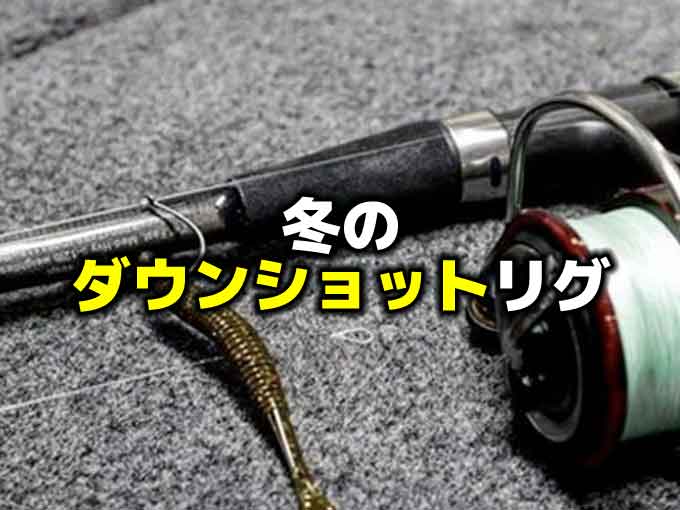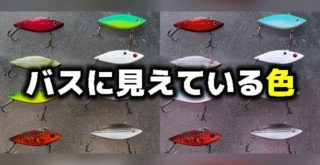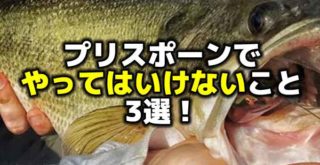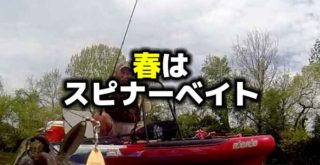ケビンバンダムのフラットエリア戦略
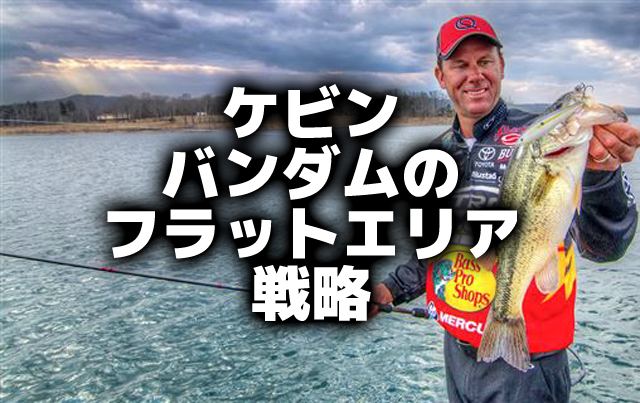
Photo by scout.com
こんにちは!店長の小山です!
本日は海外サイトより、”Distinguishing the Best Bass Fishing Flats”という記事を引用してご紹介いたします。
引用先:scout.com”Distinguishing the Best Bass Fishing Flats”David A. Brown – Aug 3, 2016(海外サイトです)
私にとってフラットエリアの釣りは、つい最近になってやり始めるようになったものです。
それまではバンク撃ちが中心で、目に見えるカバーを釣っていくというのが主な釣りでした。
今はフラットエリアも大好きなのですが、なぜかと言えば、小型船舶免許を取って機動力のあるボートに乗れるようになったからに他なりません。機動力が上がれば、魚のいないエリアに入ってしまってもすぐにあきらめがつくという、非常にシンプルな理由でした(笑)
それでもフラットエリアは、魚がいればいいのですが、ベイトフィッシュやバスが見つからないと、無駄な時間が過ぎてしまいます。魚を見つけたとしても、本当にここで良いのか?という葛藤が生まれます。
フラットエリアですから周りに何もなく、広い水面にポツンと浮いて釣りをするのは、慣れだったり、ある程度の自信が付いてこないと難しい、なんて考えたことがある方は少なからずいらっしゃるのではないかと思います。
この記事は、ご存知アメリカの偉大なるバスプロ、ケビンバンダム氏が、フラットエリアの考え方について解説しています。
彼によると、「フラットエリアはディープフラットであろうとシャローフラットであろうと、1年を通して魚がフィーディングする場所であり、フラットエリアにはいない時でも、フラットエリアが近くにある場所に魚はたまっている」と言っています。
また、「湖全体が酸素不足になった時に、風などの影響で酸素が供給されやすいのはフラットエリアだ」という、別の見方もあるようです。
なるほど、もっと細かく読んでみましょう。
フラットエリアの考え方
“It’s not just a matter of looking at a map and saying, ‘this flat will be just as good as the one that’s the same size across the lake.’ A lot of times, they have subtle differences to them depth-wise and habitat-wise,” VanDam said eschewing the notion that a flat is a flat.
“There’s a lot to it, and you just have to break down each flat and decipher what (the details) mean.”
The 4-time Bassmaster Classic winner also notes that the flats on natural lakes like those of his home state tend to present more subtle variances than those of manmade reservoirs. This makes any change in depth or habitat that much more important.
“A lot of it has to do with what’s in the surrounding area, and it’s all relative to the lake,” VanDam said. “For instance, on a highland reservoir like Table Rock, a flat that’s 50 yards wide is pretty big, whereas up in the Great Lakes, we have flats that are miles long and a 1/4- to a 1/2-mile wide with very little depth change. On Lake St. Clair, the whole lake is basically a flat.”
「地図を見ただけでは、「この湖なら、これくらいのサイズのフラットエリアがいい」とは言えません。多くの場合、深度や生息地に微妙な違いがあります。」バンダム氏はフラットはフラットであるという言い方を避けました。
「たくさんある中で、それぞれのフラットを詳しく分解して、理解することが大切です。」
4度のバスマスタークラシックのチャンピオンは、ホームとしているナチュラルレイクのフラットは、マンメイドリザーバーよりも微妙な変化を示す傾向があることに気づいています。これにより深度や生息地の変化がはるかに重要になります。
「多くのことが周辺のエリアと関係しており、それはすべて湖に対し相対的なものです」とバンダム氏は語った。例えば、テーブルロックのような高地のリザーバーでは、幅45メートルのフラットはかなり大きいのに対し、五大湖では、長さが1.6キロ、幅が400~800メートルのフラットがあり、水深の変化はほとんどありません。セントクリストファー湖に至っては、湖全体が基本的にフラットです。
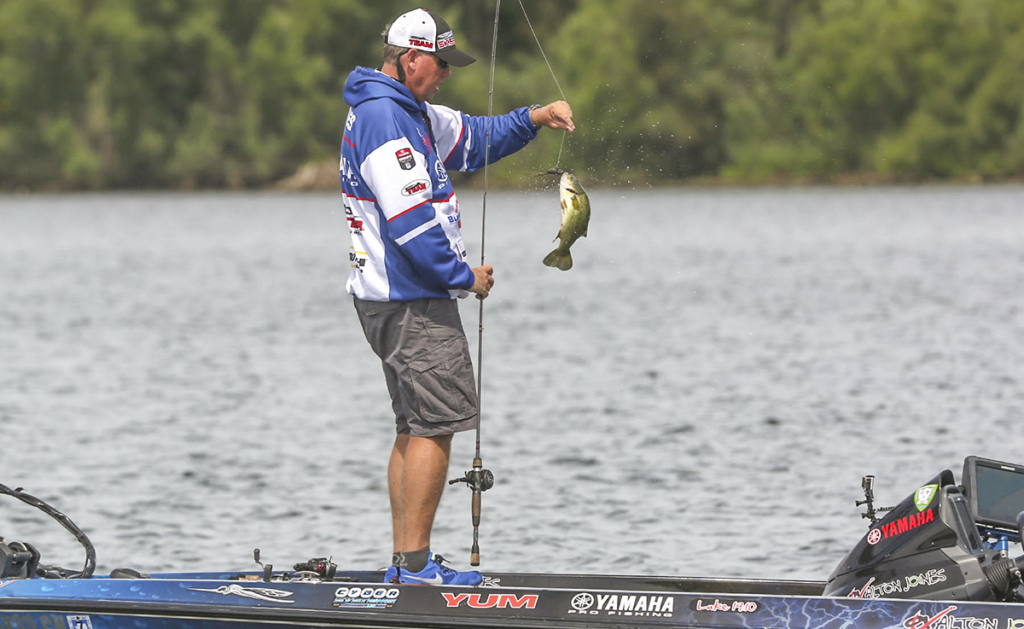
Photo by scout.com
フラットを分解する
Cover: Bass may roam open water in certain low-light scenarios, but typically, cover is key. Grass is most common, as it harbors forage and provides bass concealment. Identifying the areas with vegetation immediately puts you in productive water.
“If you have a flat with milfoil on it, (this grass) only grows in a certain depth zone in a lot of lakes, say from 4 to 10 feet,” VanDam said. “So the bigger a flat is with that 4- to 10-foot zone, obviously the more grass it’s going to have and the bigger a population of fish it’s going to support.”
Geography: VanDam likes flats that taper into main lake points, as well as those that connect with major bays or creeks. Such positioning puts the flat right along migration routes and ensures groups of fish will be on or near the flat most of the year.
“How a flat lays out in relation to the river channel is important on a reservoir because of current,” VanDam said. “A flat in a bay is not the same as a main lake flat on Kentucky Lake.”
Follow the routes: Elongated depth variances found in drains and channels are the avenues of travel for predators and prey. VanDam targets even slight drops because they typically have the best grass.
Each time the Costa FLW Series holds a Potomac River event out of Marbury, Maryland, the fertile flats on either side of the main channel leading into Occoquan Bay and a lesser residential offshoot attract several anglers who fish the dense milfoil and eel grass beds.
Even small ditches slicing across flats can concentrate bass. Case in point, Casey Smith won the recent bass tournament on the Potomac by focusing on a ditch running across the massive grass flat just south of Aquia Creek. Dumping into a 12-foot hole, the modest lane dropped from the surrounding depth of 4-6 feet to about 7-8. Working the edges, especially where the ditch met the hole, proved most productive.
Fishy bottoms: VanDam finds that bottom composition can separate good flats from great ones — depending on what he’s targeting. Soft bottoms sprouting lush grass is largemouth heaven, while flats with scattered rock and sandy patches are ideal for brown fish.
カバー:バスはローライト時など特定の状況下では回遊をしているかもしれませんが、通常はカバーが重要です。ウィードはベイトを抱えており、バスの隠れ家も提供するので、最も一般的です。ウィードのあるエリアを見つけられた場合はかなり可能性が高くなります。
「もしあなたがフラットエリアでフサモを見つけた場合、このウィードは多くの湖の特定のレンジ、例えば1.2から3メートルまでしか生えません」とバンダム氏は言いました。 「その1.2から3メートルのゾーンが明らかにもっと広いフラットエリアの場合、ウィードも多くなり、抱える魚の数も増えます」
地理学:バンダム氏は、メインレイクの岬に向かって先細りになるようなフラットエリアと、そこに隣接する主要なワンドやクリークを要するフラットエリアが好きです。このような場所は、年間を通して魚の群れがその周辺や近くを回遊するルートになっているからです。
バンダム氏は、「フラットとリバーチャンネルがどのような関係になっているかは、流れのあるリザーバーにとって重要なもので、ワンドにあるフラットと、リザーバーであるケンタッキーレイクのメインレイクにあるフラットは同じではありません」と述べています。
ルートをたどってください:流れ出しやチャンネルに見られる細長い深さの違いは、捕食者と獲物のための道のりです。 バンダム氏は通常、ウィードエリアを釣っているため、わずかな落差でもターゲットにしています。
ポトマック川でコスタFLWシリーズが開催されるたびに、オクサン湾に通じるメインチャンネルの両側にある広大なフラットエリアか、それより小さくてもフサモやアマモが密集するところにアングラーが集まって釣りをします。
フラットを横切る小さな溝でさえ、バスを集めることができます。 ケーシー・スミス氏は、アクア・クリークのすぐ南にある大規模なウィードフラットエリアを横切って走っている溝に焦点を当て、ポトマックのバストーナメントで優勝しました。直径3.5メートルほどのウィードの穴に投げ込み、その溝の部分は周囲が深さ1.2~1.8メートルから約2.1〜2.4メートルに落ちていました。特に穴と溝が合ったところのエッジで、最もバスが釣れることが分かりました。
釣るべきボトム:バンダム氏は、ボトムの質が、彼が目標とするものに応じて、優れたフラットを分けて考えることができることを発見しました。青々としたウィードが生えている柔らかい底はラージマウスバスの天国ですが、岩や砂のパッチが散在しているフラットはスモールマウスバスに理想的です。
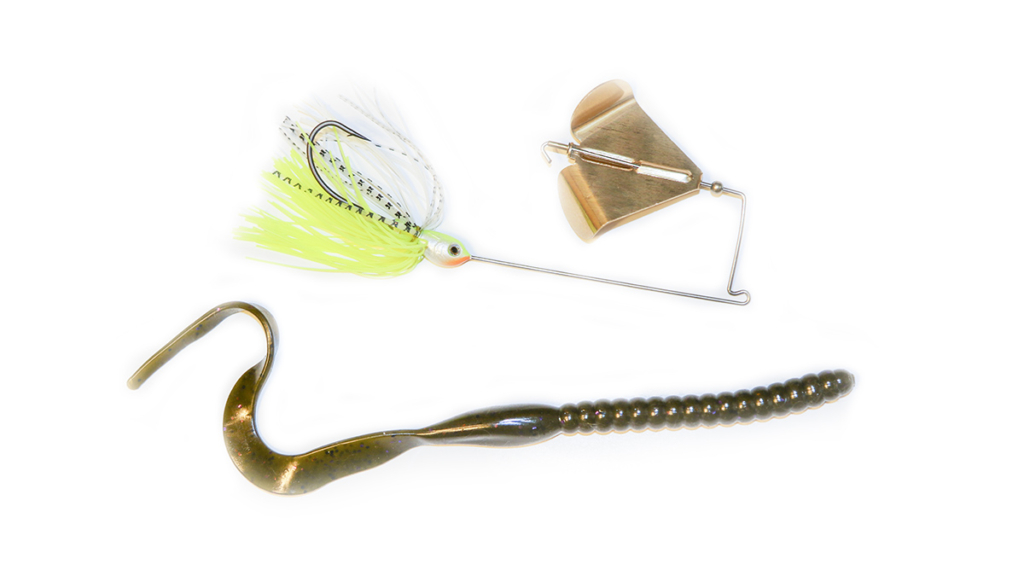
Photo by scout.com
フラットエリアに適したルアー
When he’s exploring a flat, especially during tournament practice, VanDam makes good use of his electronics to locate high spots, depressions, rock piles, stumps and grass; but often, he just fishes his way into enlightenment.
“You have to use presentations that allow you to efficiently cover the depth zone you’re trying to target for the types of cover,” VanDam said. “If the water is stained and I’m fishing shallower grass, lipless crankbaits are one of my favorite baits for those flats in less than 10 feet.
“If it’s clear, you want to use some that draws bass from long distances and triggers bite. Something like a jerkbait or a spinnerbait is a great way to cover a lot of water quickly.”
Once he runs into the fish with his search baits, VanDam will pick apart the hot zone with baits appropriate to the depth and fish positioning. His common mix includes a dropshot, football head and Carolina rig.
In his Potomac win, Smith caught most of his bass on a 4.8-inch Keitech Swimbait in bluegill flash rigged on a 6/0 wide gap hook with a 1/4-ounce belly weight. A 7/16-ounce Gambler Southern Swim Jig with a purple Yamamoto Swim Senko and 1/2-ounce watermelon Chatterbait with a Keitech Swing Impact trailer also produced flats bites.
For his flats fishing, Jones goes with a one-two punch of a reaction bait and then a more subtle follow up. His strategy seeks first to draw strikes, but secondly to identify targets.
“It may be a buzzbait followed by a ribbontail worm, it may be a squarebill followed by a tube, it may be a swimbait followed by a creature bait,” Jones said. “You have to throw some type of moving bait that allows you to know that a bass was following or interested in your lure.
“Sometimes a fish wants country and western in a certain order. There are days when the moving bait will activate the fish and the slow bait will catch them, but you’ll never catch them on the slow bait unless you activate them with the moving bait.”
彼がフラットエリアの探索、特にトーナメントのプラクティス中のときなどは、魚探を利用して、ハンプ、窪み、ロックパイル、スタンプ、ウィードを見つけています。しかし、しばしば彼は、何かを確かめるように釣りをします。
バンダム氏は、「カバーの種類とレンジを効率的に攻められるプレゼンテーションを使用する必要があります。 水が濁っていて、シャローウィードを釣る場合、3メートル以下の場所では、バイブレーションが私の好きなルアーの一つです。」
「クリアウォーターであれば、遠くからバスを引っぱってきてバイトするきっかけを与えるものを使いたいと思っています。ジャークベイトやスピナーベイトのようなものは、広いエリアすばやくカバーする素晴らしい方法です」
サーチベイトで魚に遭遇したら、バンダム氏は一旦そこを離れて、深さと魚の位置に適したルアーでホットゾーンを撃つでしょう。一般的に彼の扱うものは、ダウンショット、フットボールジグ、キャロライナリグなどがあります。
彼がポトマックで優勝した時、先ほど登場したスミス氏は、ケイテックの4.8インチのスイムベイト(ブルーギルフラッシュカラー)に6/0の1/4オンスウエイテッドワイドゲイプフックに取り付け、ほとんどのバスをキャッチしました。ゲーリーヤマモト・スイムセンコー(パープル)を7/16オンスのギャンブラーサザンスイムジグにつけたもの、ケイテック・スイングインパクトをトレーラーにした1/2オンスのチャターベイト(ウォーターメロン)もフラットでバイトを得ました。
ジョーンズ氏はフラットでの釣りで、リアクション系のルアーで1,2本釣った後、より微妙なフォローアップを行います。彼の戦略は、まずはバイトを得た後に、ターゲットを絞り込んでいくことを目指します。
ジョーンズ氏は、「バズベイトのあとに続くのがカーリーテールのワームであるかもしれないし、スクエアビルクランクの後にチューブワームが続くかもしれないし、スイムベイトの後にクリーチャーワームかもしれない」と語った。 「まずはどのタイプのムービング系ルアーに追ってくるか、興味を示すのかを見なければなりません。」
「時には魚の方が特定の組み合わせを望んでいます。ムービングルアーが魚を活性化させ、ワームがそれらを捕まえる時がありますが、ムービングルアーでバスを活動化させない限り、ワームでもそれらを捕まえることはありません。」
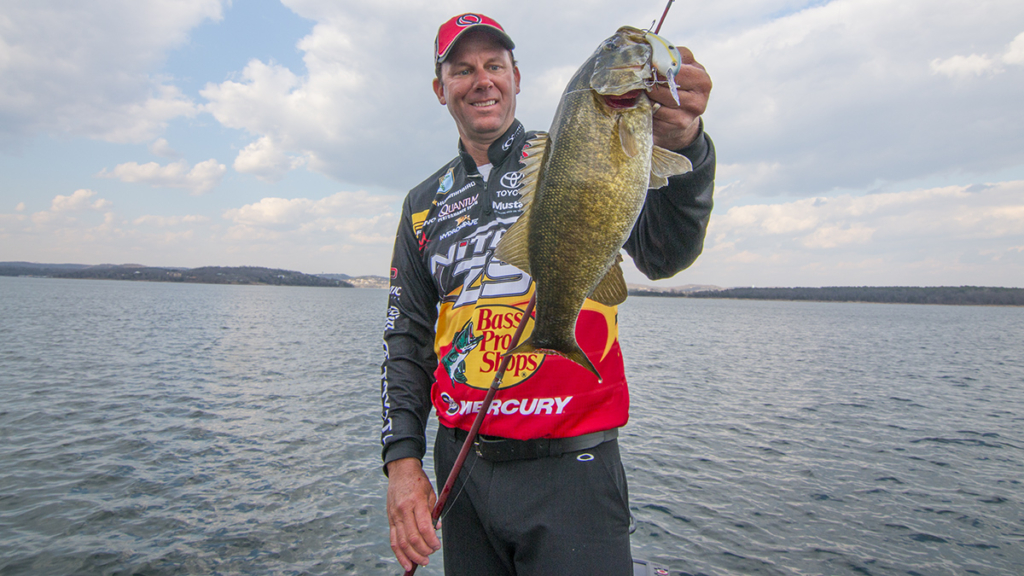
Photo by scout.com
いかがでしたか。
さすがフラットエリアというだけあって、変化は少ないですから、その少ない変化を探すというのがまず第1工程なんですね。
少ない変化を探したら、次は魚の活性を上げるために巻き物系でやって、チェイスや何か反応があったら、その地点で遅い釣りを展開する。巻き物系で釣れるならそれはそれで、そのあとにもワームを入れてみると。
たしかに、カバーの中のようにピンポイントで待ち伏せするバスと違って、フラットエリアにはそもそもベイトを食べようとしているバスが群れでいるわけですから、バスたちにスイッチを入れてあげないといけませんし、スイッチが入ってしまえば連発するのでしょうね。
この内容から、今後どれだけの自信につなげられるかはわかりませんが(笑)、もっと確信をもって広大なフラットエリアで釣りができるよう、魚探などで細かいことにも気にしてみたいと思います。
それでは、また。
毎度ありがとうございます!





